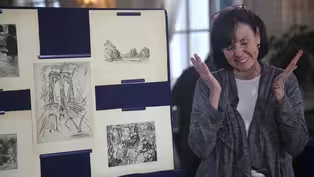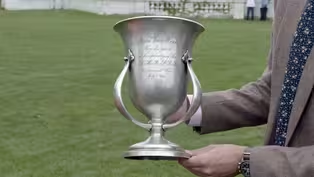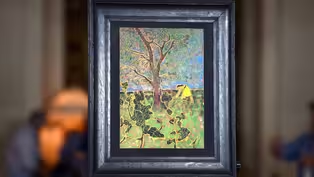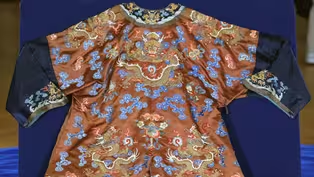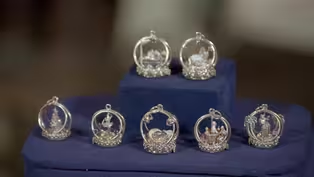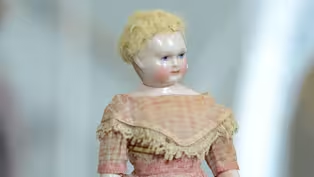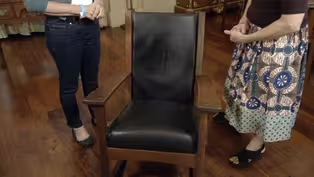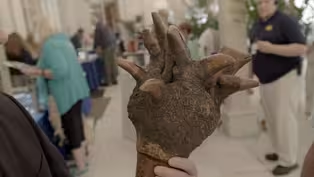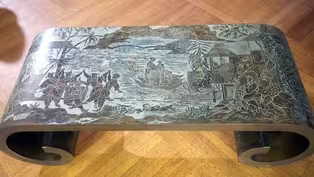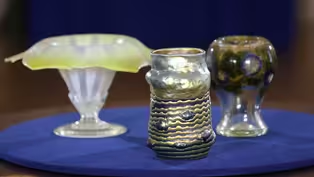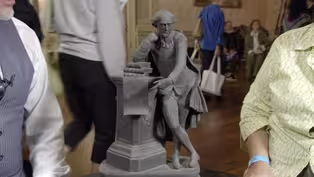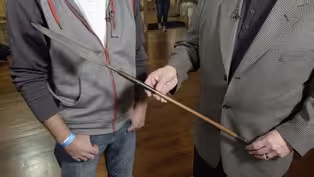
RECUT: Newport, Part 2
Season 24 Episode 29 | 22m 30sVideo has Closed Captions
Learn about historical finds as they are appraised at a Gilded Age mansion in this RECUT!
Learn about historical treasures as they are appraised in a Gilded Age mansion! In this half-hour RECUT, ROADSHOW travels to Rosecliff for finds including Tiffany Studios vases with the original crate, a Benny Andrews oil from around 1962, and more.
Problems playing video? | Closed Captioning Feedback
Problems playing video? | Closed Captioning Feedback
Funding for ANTIQUES ROADSHOW is provided by Ancestry and American Cruise Lines. Additional funding is provided by public television viewers.

RECUT: Newport, Part 2
Season 24 Episode 29 | 22m 30sVideo has Closed Captions
Learn about historical treasures as they are appraised in a Gilded Age mansion! In this half-hour RECUT, ROADSHOW travels to Rosecliff for finds including Tiffany Studios vases with the original crate, a Benny Andrews oil from around 1962, and more.
Problems playing video? | Closed Captioning Feedback
How to Watch Antiques Roadshow
Antiques Roadshow is available to stream on pbs.org and the free PBS App, available on iPhone, Apple TV, Android TV, Android smartphones, Amazon Fire TV, Amazon Fire Tablet, Roku, Samsung Smart TV, and Vizio.
Buy Now
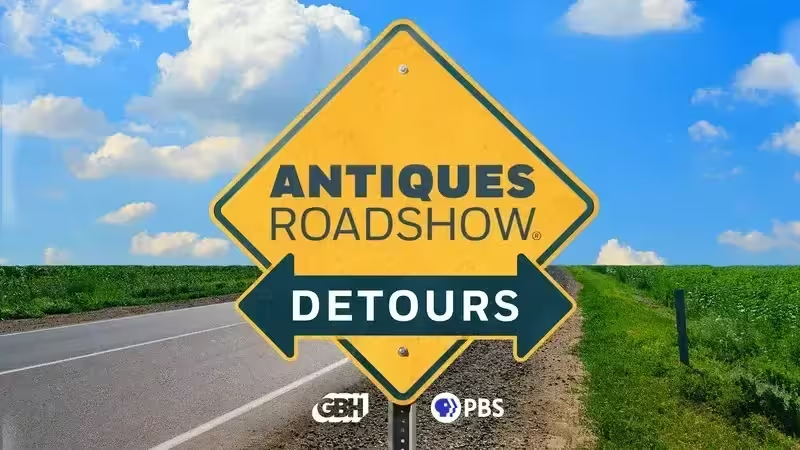
ANTIQUES ROADSHOW DETOURS
Ever wondered what happens to the treasures featured on America’s beloved ANTIQUES ROADSHOW after the cameras leave town? Host Adam Monahan tracks down the juicy afterlives of your favorite finds from PBS’s hit series.Providing Support for PBS.org
Learn Moreabout PBS online sponsorshipMore from This Collection
America’s favorite treasure hunt ANTIQUES ROADSHOW presents a bite-sized way to enjoy the show. ANTIQUES ROADSHOW RECUT features thirty-minute episodes, packed full of favorite finds and paced for maximum entertainment. RECUT features episodes recut from the show’s previous visits to distinctive and historic locations across the country.
Video has Closed Captions
Experience Part One of ROADSHOW’s groundbreaking visit to Rosecliff mansion in a RECUT! (22m 30s)
Providing Support for PBS.org
Learn Moreabout PBS online sponsorship♪ CORAL PEÑA: It's the second part of "Antiques Roadshow Recut" from Newport, Rhode Island.
When I saw this...
I was kind of excited.
You're freakin' kidding me.
(chuckles) PEÑA: Stay tuned for part two of "Antiques Roadshow Recut: Rosecliff."
♪ PEÑA: During the Gilded Age, Newport was a hotspot for captains of industry and queens of high society to summer on seaside estates.
The impressive Rosecliff Mansion was such a place for heiress Tessie Oelrichs.
Check out the treasures that made an impression on "Roadshow" experts at Rosecliff.
MAN: My son and I go to auctions and estate sales looking for junk.
It was a rainy morning, and there were box slats out on the grass of this auction.
And, uh, nobody wanted to get their feet wet.
We really didn't look in the box, you know, and, you know, the frame looked really nice, so we ended up getting the box for $45.
Now, the box was in the garage drying out for a couple of days.
Wow.
And so my son got around to it, brought the box in.
This was wrapped up with another one in very old Saran Wrap.
This is exciting.
It's a really beautiful example.
You've seen the signature, you know the artist, Benny Andrews.
Benny Andrews is a favorite artist of mine, an African-American artist who did incredible work.
He's an expressive figurative artist working in the 1950s until his passing in 2006.
He was born in 1930.
And what's striking about this painting is its beauty, its interest in nature, the yellow dress, the colors.
He's known primarily as a New York artist, but he was born in Georgia.
A lot of his artwork that people know are images of the South from his childhood.
He was a very enterprising, talented young artist.
He studied at the Art Institute of Chicago in the 1950s, and moved to New York in 1958.
And he was picked up by a gallery and had his first solo show in New York in 1962.
Looks like oil with tempera.
It's got a wonderful pattern.
It doesn't have his collage, which he's really known for in the late '60s, but it's got a lot going for it: the size, the early interest in color, the pattern.
And probably another image from his childhood.
We don't see many Benny Andrews from the early '60s, and most of those are works on paper.
So this is a work on board, and it's a painting.
This is a beautiful image.
Of course, the woman in the yellow dress is, is a zinger-- it's, really draws your eye in.
Few works like this have come to auction, but those that have have done well.
Do you have any sense of what it might be worth?
Well, my son's salivating.
(chuckles) Online, asked about it, so I go, "I don't know, let's find out."
I would put it at auction, conservatively, at $7,000 to $10,000.
You're freakin' kidding me.
(chuckles) All right, well, guess it's not going online.
All right, cool.
It's an amazing find.
Right.
Congratulations.
Thank you.
Thank you for bringing it in.
I appreciate it.
♪ I found this in a trash heap in a basement where we were living, and it looked like somebody was throwing it away.
I've been carrying it from place to place for the last 48 years.
It was really tarnished, and I kind of went like this, and I saw that there was light, you know, like a silver spot.
Mm-hmm.
So I picked it up and I have been using it as a champagne holder.
Nice.
(laughing) So whenever we have champagne, I bring it out like an ice bucket.
Isaac Van Horn was a financier, and he started off in Nebraska as a grocer before moving to Boston after he made his money.
Uh-huh.
And he became an investment banker.
Oh.
And he invested in the Laramie, Hahns Peak, and Pacific Railroad... Huh.
That was built in Centennial, Wyoming, in 1907.
Wow.
So you've got this wonderful combination of railroad memorabilia... Yup.
And then this wonderful trophy cup.
So it was a gift basically from his investors.
Yup.
Because he'd invested in this railroad.
Oh.
And it's actually made by Gorham, which is right here...
Which is in Connecticut.
No, Providence, yeah.
Providence?
Oh, oh.
So right there, we've got that mark, and it's a wonderful three-handle trophy cup.
Mm-hmm .
But I think champagne is an ideal use for it.
It's made of sterling silver.
Right.
You can definitely clean it up, maybe get it professionally polished.
I think once you had it cleaned up, I'd expect it to sell for somewhere between $1,500 and $2,500.
Okay, great, thank you so much.
All right?
Yeah.
And thanks for bringing it out on this wonderful day.
It's been a wonderful experience, I love this.
I've been wanting to do this for a long time, so this is great.
Well, fantastic-- thanks!
♪ PEÑA: Rosecliff's marble-like exterior is actually polychrome-glazed terra cotta.
It was one of the first buildings in America to use the material.
♪ WOMAN: Well, this is my grandmother's table.
She bought it in 1982.
She was always very interested in metalwork, so we weren't surprised when she sent my uncle down in his truck to New York City to pick up this table.
We didn't really know much about it other than the fact that it was, at one point, buried in dirt.
We did a little research and found out that it was made by the LaVerne Studios?
And how much did she pay for it, do you recall?
$6,000.
$6,000.
Yes.
So, in 1982, this table would have probably retailed for more than that.
They probably actually got a good price at $6,000, believe it or not.
Yeah, she did mention that because she didn't use a designer, that they took $4,000 off the price of the table because she purchased it directly.
Right.
In the '80s, this company had already been producing these tables for about 15 or 20 years.
So in 1982, it was probably brand-new.
My information says that these were about $10,000 retail at that time.
By the mid-1980s, the design team of Philip and Kelvin LaVerne-- a father-and-son team in New York-- were very well-known.
They were highly prized works that were sold through decorators, through high-end design shops, and, of course, you can buy them directly from the LaVernes if you knew somebody.
(chuckling): Right.
It's made out of bronze with a proprietary process that Philip and Kelvin LaVerne were able to make by etching these bronze plates and attaching them to a substructure.
In this case, to a scroll shape, but the same pattern here, called the marriage whirl, would've been used on consoles, end tables, various other types of furniture.
The LaVernes took their objects and would actually bury them in a proprietary mix of soil to give it a patina.
Your example is in really beautiful condition.
There's no heavy scratches, dents.
I think that if this came up in a well-publicized auction, it would probably sell for between $15,000 and $20,000.
Well, that's... that's really good.
(laughs) I'm just a little stunned.
(laughs) Very good.
Yeah.
APPRAISER: The mountings are in incredible condition, fantastic filigree work on the edges, stones were simulated.
I would appraise these retail at about $750 each.
Oh, okay.
They are wonderful.
Great.
I did find quite a few plaques similar to this-- but not exactly like it, but similar in size... Uh-huh.
And of course, the same subject.
And they all seem to be selling for around $150 to $250.
Oh, okay, wow.
I don't know that you'll ever figure out who the artist is, though.
Right-- isn't that interesting?
PEÑA: One of Rosecliff's most impressive features is the unique "sweetheart" staircase, limestone stairs with a grand heart-shaped opening.
Well, the history of the family goes, it came down through my great-great-uncle, and my, it was passed on to me from my grandfather.
This is actually a Zulu dance spear, and there're some elements that are really cool.
This is horn here, and these little dots are actually bone.
Down here we have the same inlay.
This is really a terrific example.
I think this easily could be mid-19th century, so 1850 at the earliest.
Oh, wow-- it's older than I thought.
And at a good auction, I would say $800 to $1,200.
Oh, wow, excellent!
♪ You got it from your parents, masted ship, American flag.
The artist, Reuben Chappell, is a British artist.
It's a great painting.
It's a great maritime painting.
Is it presently insured?
If you say it should be, it will be.
WOMAN: It's been in our family for so long...
I mean, generation after generation, and it's been in all our drugstores that our family's owned, so... 1690, in this condition, you're probably talking in the $500 range.
Oh, okay.
Probably half the medicines would kill you far quicker than anything else.
APPRAISER: This is part of an 1860 naval cutlass.
It originally would have had a leather scabbard with copper rivets all the way down the back.
Okay.
It's missing the scabbard, it's missing the hand guard, so it's probably worth about $70, $75.
Well, my aunt, when she passed, left a few things, and each of her nieces and nephews were allowed to select some things.
I loved them because they, they're mechanical, and you wind them up, and then different things happen in each one of them, so, that was why I have always been fascinated by them and just wanted to know a little bit more.
They are made by Henry Dankner & Sons.
They were a family that had escaped Nazi Hungary.
Oh, wow.
Re-established in the New York jewelry market in the 1950s, and filed a patent for these in 1965.
Which is your favorite?
You know, I kind of loved the heart, which goes up and down when you wind it.
Can you show me how it works?
And then... Sure.
Wow.
And this one, I think, has the most motion in it with the, with the horses.
It's a great collection that's enough to make an instant bracelet for somebody.
(laughs) And if they were coming to auction, I believe they would do an auction estimate of $4,000 to $8,000.
Oh, my goodness, wow.
Wow, thanks, Aunt Alice.
That's great.
♪ PEÑA: Many of the furnishings at Rosecliff today, including this late-17th-century tapestry depicting the Wedding of Andromeda, were owned by the estate's last private owners.
My grandmother passed away recently, and I found it in her attic.
She didn't do any extensive traveling in Asia that I'm aware of, but I think her parents may have at some point.
So did you know that the robe was Chinese?
I had a feeling.
Well, it's Chinese, and it's actually kind of unusual because of a number of different features.
One, it's for a child.
Okay.
But the child was also probably a eunuch.
Oh, really?
And a servant in the palace.
Mm-hmm.
These robes are pretty standardized from the 17th century to the 20th century, but certain things change, and one of the things that change is this area in the robe, on the bottom.
It's called lishui.
Later on, into the 20th century, this gets longer and longer and longer, and one of the reasons why, it was the easiest part of the robe to embroider.
Mm-hmm.
So, basically, they were cost-cutting on it.
The motif on the bottom actually represents the firmament, and then the dragons are all couched in gold thread.
Mm-hmm.
And that gold thread was gold leaf that was actually wrapped around threads and used for the embroidery.
There are these round figures with the flames, and those are celestial pearls, and there are bats on the robe, too, but bats just mean prosperity.
The robe is silk, the embroidery is also silk.
At this period of time, which was about the 1850s, there were just a huge quantity of people attending, basically, the emperor's every needs.
And it was people like this that were doing the clean-up work.
Sure.
Even in these robes.
At auction, I would expect this robe to sell for around $2,000.
Wow, great.
♪ APPRAISER: This would've had a handle.
WOMAN: Yeah.
So which, if you would heat it up first of all, because this big, thick slab of iron, it would've maintained that heat for a long, long time.
So you could have used it and used it, and then when you were finished, you could knock it off, you could grab another one if you had that going, and you could interchange the handles.
Okay.
So date-wise, turn of the 19th century.
In a local shop, that's maybe $15, okay?
Okay, good.
This was my, at my grandmother's house.
I'm not sure if she owned it or if it was left at the house from previous owners, but I grew up with it, always staring at it, and I'm curious to see if it's worth anything today.
It's a porcelain or china cat, it's got a stamp from England, and that's about all I know.
APPRAISER: Stylistically, the china-painted stuff tends to be more Victorian or Art Nouveau.
Stylistically, it's not a turn-of-the-century design.
Right.
So it's a black Japanese Satsuma piece that was sent here and then decorated here.
Her name is Clotilde.
She was purchased in France when my great-great-grandmother had traveled on a European tour, and she gave it to her daughter, my great-grandmother, who, in the picture, is holding the doll.
What we're looking at is a doll made by Leontine Rohmer.
She was a very prolific French doll-maker, and it was an interesting that a woman at that time could run an entire business.
The doll is made of porcelain.
This type of porcelain that's glazed on a white background, we call that china.
The shoulders are the same material, the arms are the same material, the body is of kid leather.
It would have a mark in this area of the chest, of the leather.
I looked and the mark has worn away, it's no longer there, but it would be a green stamp that said, "Mademoiselle Rohmer."
This is a very early doll, probably in the 1860s that this doll was made.
And it has her original dress, original underwear.
Also, sitting on the table here is her original hoop skirt.
Mm-hmm.
She does have a bit of damage that goes up her cheek, up to the eye.
Mm-hmm.
That can be repaired.
Mm-hmm.
It would cost about $250 or $300.
But it, it would help the value of the doll.
Mm-hmm, mm-hmm.
But as the doll sits today, she would sell for $2,500 retail.
Oh, my goodness.
If you had the repair done on the cheek, it would raise the price to $3,500.
That's not what we expected at all.
(laughing) It was worth waiting for, that...
Yes, it was, it was.
PEÑA: The mansion itself reportedly cost about $2.5 million to build at the turn of the 20th century.
That was over $60 million in 2018.
WOMAN: During the Depression, my aunt was, started buying up these vases from Tiffany's, so I guess she ordered some by the crate-load.
It actually says, "Louis C. Tiffany Studios," with an address.
The crate in itself, it's something you don't see very often, with "glass" plastered all over the sides.
But I also want to point out the straw.
(chuckles) Because it's not often that people keep the shipping crates.
The first piece of glass over here, which is what we would call pastel glass... Mm-hmm.
Is later-production Tiffany-- it was made in the '20s.
Okay.
It was made in multiples, and it came in different colors.
These are the colors that you see in some of the Depression glass of the era... Mm-hmm.
But this was a lot more expensive than your average piece of Depression glass.
Now, this piece is a paperweight glass vase.
Mm-hmm.
Leslie Nash, who worked for Louis Comfort Tiffany, claims that while they were working with paperweight glass, Louis Tiffany himself, who was a painter, came into the glass-working shop, handed them a painting of morning glories that he had painted, and said, "I want you to make this in glass."
Wow.
Supposedly, it took $12,000 in R&D... Mm-hmm.
to create this kind of glassware.
1914 is when they first introduced it.
Your piece, on the bottom, actually says "exhibition piece" on it.
I know from the date letter, which is a suffix L, that that would be somewhere around 1915.
Okay.
So it's possible that this could've gone to the 1915 San Francisco International Exhibition.
I think it came back to the studios, that's the interesting part.
You may have seen vases like this.
They're in many museums all over the world.
I think I saw one at the Met in New York, mm-hmm.
Yes, and the one at the Met has a number on the bottom, which is 1130-L. Yours is 1132-L. Oh.
So this is two numbers after the Met's vase.
Okay.
The Met acquired it in 1924, even though it was probably made in 1915.
So these things still were sold later.
The crate, in a retail setting, this is something for Tiffany geeks everywhere-- collectors, museums.
They would actually be very excited about this, and it would be worth between $5,000 and $10,000.
Holy cow!
This piece, which is not as sought-after as some of the other art glass... Mm-hmm.
would retail probably between $2,000 and $3,000.
But this piece, in a retail shop, it could be sold for anywhere between $50,000 and $75,000.
No way!
Oh, my gosh!
I was... thinking maybe $8,000 to $10,000, I was hoping.
Wow.
Well, that was a long time ago.
Wow, I really didn't know what the market had done, you know, if it had gone sideways or up or down, but... wow.
(inhales) So there's one other thing in here that I want to talk about.
This vase.
This practically stopped my heart when I saw it in the box.
(giggling) This is the piece I was waiting for for 20 years.
Oh, wow.
And every night before the Roadshow, people would always say, "What is on your wish list?
What would you like to come in to the show tomorrow?"
And I always say, "A Tiffany Lava vase."
Wow.
And that's what this is.
It's extremely special.
It is meant to look like molten lava... Mm-hmm.
on the surface of the vase, and this one is particularly interesting because you also have these protrusions here.
It's very similar to a vase that was shown in the 1906 Paris Salon Exhibition.
Oh!
A very similar example is in the collection of the Musée des Arts Décoratifs in Paris, and it's been there since 1906.
Gee.
So when I saw this...
I was kind of excited.
(laughing) Oh.
The thing about Lava is, it was very hard to make.
They get cracked in the making.
Oh.
And I did go over your Lava with my special light and a magnifying glass, and I couldn't find any imperfections.
An example like this, in a retail shop, could sell between $100,000 and $150,000.
(laughing) Where's my brother?
He... (laughs) Wow.
That's unbelievable.
I had no idea.
I just can't believe that your aunt bought all of this in the late '20s and the early '30s.
Yeah.
It's... it's pretty remarkable.
PEÑA: You're watching the second part WOMAN: I bought this about a year ago from a local dealer.
Let's check it out on the back.
Sure.
So it's relatively rare to find furniture with signatures on it, and your chair has two.
One of them is a decal label from the L. & J.G.
Stickley Furniture Company.
The label that's on it is this rectangular shape.
Right.
Which means that it was made between 1912 and 1920.
And it also is stamped "Breakers Cottages."
Yes, yes.
Which probably was not done by the Stickley Company themselves, but probably from either the preservation society once they took over the Breakers, or the Vanderbilt family themselves.
Of course, Cornelius Vanderbilt built it, but he furnished his home with really fanciful European furniture.
And this was an oak, pretty pedestrian piece.
That's what confused me a little bit.
Yes, I am guessing that this probably came out of either the servants' quarters or...
It was a utilitarian piece, because by the time this was made in 1912 to '20, it wasn't made by Gustav Stickley, the grandfather of the Arts and Crafts movement-- he made very expensive furniture.
His brothers then went on to make a little more pedestrian furniture...
Okay.
More affordable.
Any idea of its value, or...?
I paid $750 for it.
Well, I would probably insure this in the range of $800 to $1,200.
Oh, great, great.
Yeah.
It's a connection between the Arts and Crafts movement and one of the grand homes here in Newport.
Oh, thank you.
PEÑA: Thanks for watching.
Tune in again for another great episode of "Antiques Roadshow Recut."
Appraisal: 1907 Isaac Van Horn Silver Trophy
Video has Closed Captions
Clip: S24 Ep29 | 1m 37s | Appraisal: 1907 Isaac Van Horn Silver Trophy from Newport, Part 2. (1m 37s)
Appraisal: Benny Andrews Oil Painting, ca. 1962
Video has Closed Captions
Clip: S24 Ep29 | 2m 37s | Appraisal: Benny Andrews Oil Painting, ca. 1962, from Newport, Part 2. (2m 37s)
Appraisal: Chinese Child's Robe, ca. 1850
Video has Closed Captions
Clip: S24 Ep29 | 1m 49s | Appraisal: Chinese Child's Robe, ca. 1850, from Newport, Part 2. (1m 49s)
Appraisal: Dankner & Sons "Living Charms," ca. 1975
Video has Closed Captions
Clip: S24 Ep29 | 1m 7s | Appraisal: Dankner & Sons "Living Charms," ca. 1975, from Newport, Part 2. (1m 7s)
Appraisal: Leontine Rohmer Doll, ca. 1865
Video has Closed Captions
Clip: S24 Ep29 | 2m 4s | Appraisal: Leontine Rohmer Doll, ca. 1865, from Newport, Part 2. (2m 4s)
Appraisal: L. & J.G. Stickley Oak Rocking Chair, ca. 1915
Video has Closed Captions
Clip: S24 Ep29 | 1m 39s | Appraisal: L. & J.G. Stickley Oak Rocking Chair, ca. 1915, from Newport, Part 2. (1m 39s)
Appraisal: Penobscot Carved Root Club, ca. 1850
Video has Closed Captions
Clip: S24 Ep29 | 34s | Appraisal: Penobscot Carved Root Club, ca. 1850, from Newport, Part 2. (34s)
Appraisal: Philip & Kelvin LaVerne Table, ca. 1982
Video has Closed Captions
Clip: S24 Ep29 | 2m 23s | Appraisal: Philip & Kelvin LaVerne Table, ca. 1982, from Newport, Part 2. (2m 23s)
Appraisal: Tiffany Studios Vases & Crate
Video has Closed Captions
Clip: S24 Ep29 | 5m | Appraisal: Tiffany Studios Vases & Crate from Newport, Part 2. (5m)
Appraisal: Wedgewood Basalt Shakespeare Figure, ca. 1910
Video has Closed Captions
Clip: S24 Ep29 | 32s | Appraisal: Wedgewood Basalt Shakespeare Figure, ca. 1910, from Newport, Part 2. (32s)
Appraisal: Zulu Dance Spear, ca. 1890
Video has Closed Captions
Clip: S24 Ep29 | 40s | Appraisal: Zulu Dance Spear, ca. 1890, from Newport, Part 2. (40s)
Providing Support for PBS.org
Learn Moreabout PBS online sponsorship
- Home and How To

Hit the road in a classic car for a tour through Great Britain with two antiques experts.













Support for PBS provided by:
Funding for ANTIQUES ROADSHOW is provided by Ancestry and American Cruise Lines. Additional funding is provided by public television viewers.


